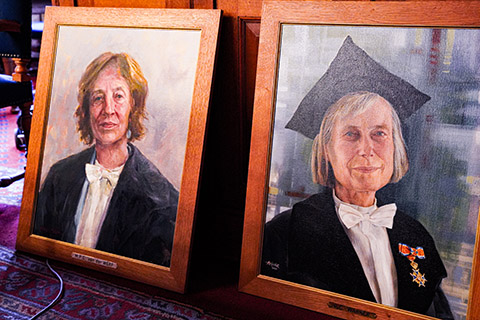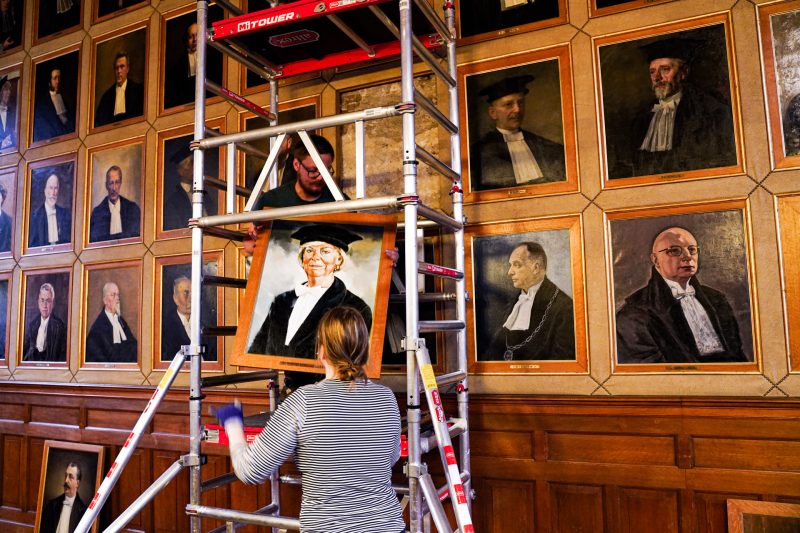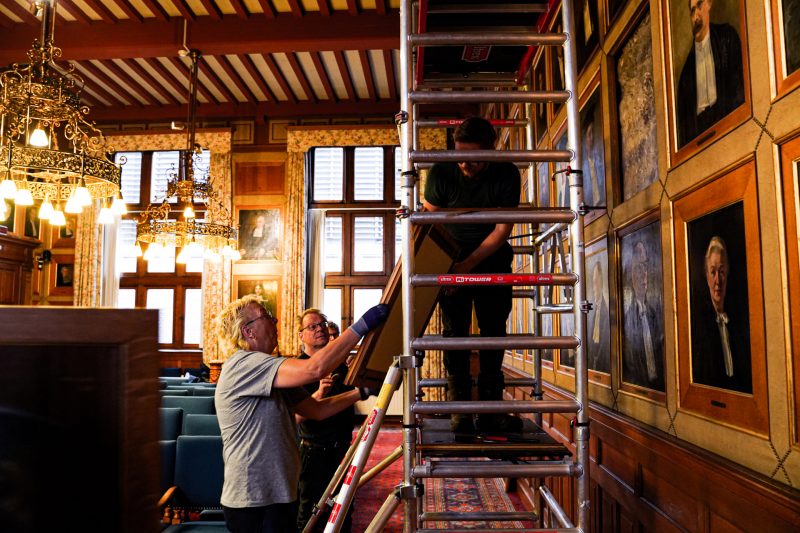
Female professors
join Senate Chamber
gallery
More women,
less grave
Striking green backgrounds, delicate pearl earrings, crimson gowns, and long flowing hair feature among the eleven new portraits of female academics hung last week in the university’s gallery-cum-auditorium – the Senate Chamber. In the process making the tradition, which has its beginnings in 1618, one that is more colourful, inclusive and representative of today’s university.
Arjen Dijkstra, director of the University Museum who has overseen the process of organising, painting, and hanging the portraits, says that until now, ‘the image we have been painting of the university has been one of white, elderly men’. The eleven new female faces to hang along the existing collection ‘is a start in recognising this is no longer the institution we are today’.
Funded
Traditionally, professors or their families and followers have funded the portraits, which cost between six and eight thousand euros, themselves. ‘This changed too, the university has paid for this latest set’, Dijkstra says.
In one year, we have tripled how many women are displayed on the walls here
‘The last university board made the decision that the portraits, which are after all representations of the university community, ought to be brought up to date’, recalls Dijkstra. Faculties were asked to select two female professors, current or retired, who were to be painted and hung in the chamber.
Among those painted, says Dijkstra, are women ‘who have made extensive contributions to the UG or who have won major prizes like the Spinoza’. ‘In one year we have tripled how many women are displayed on the walls here in the chamber’, Dijkstra observes.
Dead
Dead men, it seems, are no longer the best representation of today’s UG. Instead it’s those like professor of demography Clara Mulder. Mulder, who has been a professor at the UG since 2011, was selected by her faculty, Spatial Sciences, to be painted.
‘Our former dean arrived at my office door one afternoon quite simply and asked: ‘Would you be willing to be portrayed? But please keep it a secret’, explains Mulder. ‘I remember telling him to give me a moment to think about it. Within the hour I had said yes.’
Mulder recalls being taken on a tour with her fellow portrait subjects around the existing collection in the academy building. ‘I remember thinking I didn’t want my portrait to be so dark, so severe, so serious.’ Instead, she selected a painter who could add some vibrancy and colour to the otherwise grave collection.

The Senate Chamber gallery being updated
A gentle air
‘I went with Carla Rodenberg in the end’, says Mulder. ‘Coincidentally, she had painted the former Queen, Beatrix, but what really appealed about her style was her not too preciseness and her ability to lend a gentle air to her portraits.’
Mulder spent much of the previous autumn travelling back and forth to Rodenberg’s atelier in a Gouda attic to be painted. ‘It was an autumn I look back on with much fondness. We ate together, my husband, brother and brother-in-law came along too, and Carla and I got on very well’, beams Mulder.
While humble about the process, Mulder also admits she is proud of her new position in the chamber. ‘I am a bit proud I suppose’, she smiles coyly, ‘but at the time I was the only full female professor in the faculty so perhaps I got lucky too…’
The best
Given the paintings serve as representations of the best of the university, Mulder says this is certainly a good step in better illuminating the whole university community.
‘The other day I was in a faculty chamber, very similar to the Senate chamber, handing out bachelor’s degrees. One young student remarked that the many men on the wall were, well, anachronistic.’ Mulder couldn’t let on too much, she remembers, ‘But I did say, it’s all right, we are working on it.’ At least in the Senate chamber.
The unveiling of the fifteen new portraits (four men, eleven women) this Tuesday is the culmination of efforts to increase the visibility of female staff that started in part with Mineke Bosch, professor of modern history. In the lustrum year 2014, Bosch and colleagues developed an augmented reality application which would add images of female academics to places devoid of female representation.
New tradition
Bosch is rightfully proud of the progress. ‘I am very happy about it – it goes to show that with enough pressure things can and do change.’ Bosch says that because ‘many female professors are perhaps more modest about their achievements and would not think of donating a portrait themselves’, it is wise of the university to foot the bill and arrange the new tradition in this way.
I’m quite excited to see more living figures portrayed too, not just retired men
The process of painting these new portraits, hindered by Covid-19, has taken the best part of two years. ‘Some artists can move very quickly, others require much more time. At the end of the day, all of the portraits have to be hung at once otherwise they can’t be unveiled at the same time’, Dijkstra explains.
‘We have a catalogue of artists, Marcel Duran and Carla Rodenberg feature for instance, and those portrayed may consult this to see who they would like to paint them. Of course, they can also select a painter themselves.’ The only rules: they must be painted in their regalia and wearing honours; style, colour palette and whether or not they smile is up to them.
With fifteen new portraits to be hung, and the walls already full, there is a problem. Which of the esteemed professors do you take down and where do they go?
New portraits of female professors get a place on the wall in the Senate Chamber among prominent UG professors of the past, on the right: one of the few female professors that were already up: Tine Tammes.

Moved
‘Often the portraits are simply moved to one of the faculty rooms to avoid them being in the closed stacks, and hung there instead’, says Iris Huizinga, a manager at the University Museum seconded to this project. ‘We have several portraits going to collections at other museums too – Pieter Hendrik Schoute for instance is on loan to be hung in Delft.’
The RUG formed a small committee that discussed all paintings in the Senate Room, and whether or not removing a certain picture changes an ensemble, and the cultural, artistic value of a piece.
Happily, switches like this occur organically. Huizinga explains: ‘Curtain, who was a mathematician, is being hung in Schoute’s place, who was also a mathematician – we find that wonderfully symbolic’. Moreover, it’s rare to have portraits hung of those still living hung in the Senate chamber, those who students and staff can see around the city: ‘I’m quite excited to see more living figures portrayed too, not just retired men’, says Huizinga.
We have gone from women still being denied degrees, to feeling comfortable adapting long-standing traditions like the portraits
One face still very much visible around the city is retired professor of theoretical philosophy, Jeanne Peijnenburg. Like Mulder, Peijnenburg found the process of being painted an indelible one. After seeing her former colleague John North immortalised in paint in the philosophy faculty room by artist Tijn Roebroeck, she knew. ‘They gave us a brochure of artists to choose from. I had already made my mind up – it had to be the painter of North’s portrait’, she laughs.
Honour
Painted first in acrylic then in oil, Peijnenburg spent several sessions between Roebroeck’s atelier in a decommissioned oil tank and her own home in Groningen. ‘I admire Roebroeck’s style very much, he manages to make people’s souls emerge from the canvas’, she describes.
Peijnenburg describes being selected by the then dean of her department as ‘a gratifying honour, particularly to be recognised by one’s peers in that way.’ Having first come to Groningen in 1970 as a seventeen-year-old, she says ‘I never imagined then when I was attending lectures in the Heymanszaal, in 1970, that I would end up with a portrait in the senate chamber.’
But the hanging of her portrait is part of larger changes that have occurred for women in academia, she says. ‘Over the past six or seven decades we have gone from women still being denied degrees in some European universities, to a place where we feel comfortable adapting long-standing traditions like the portraits.’